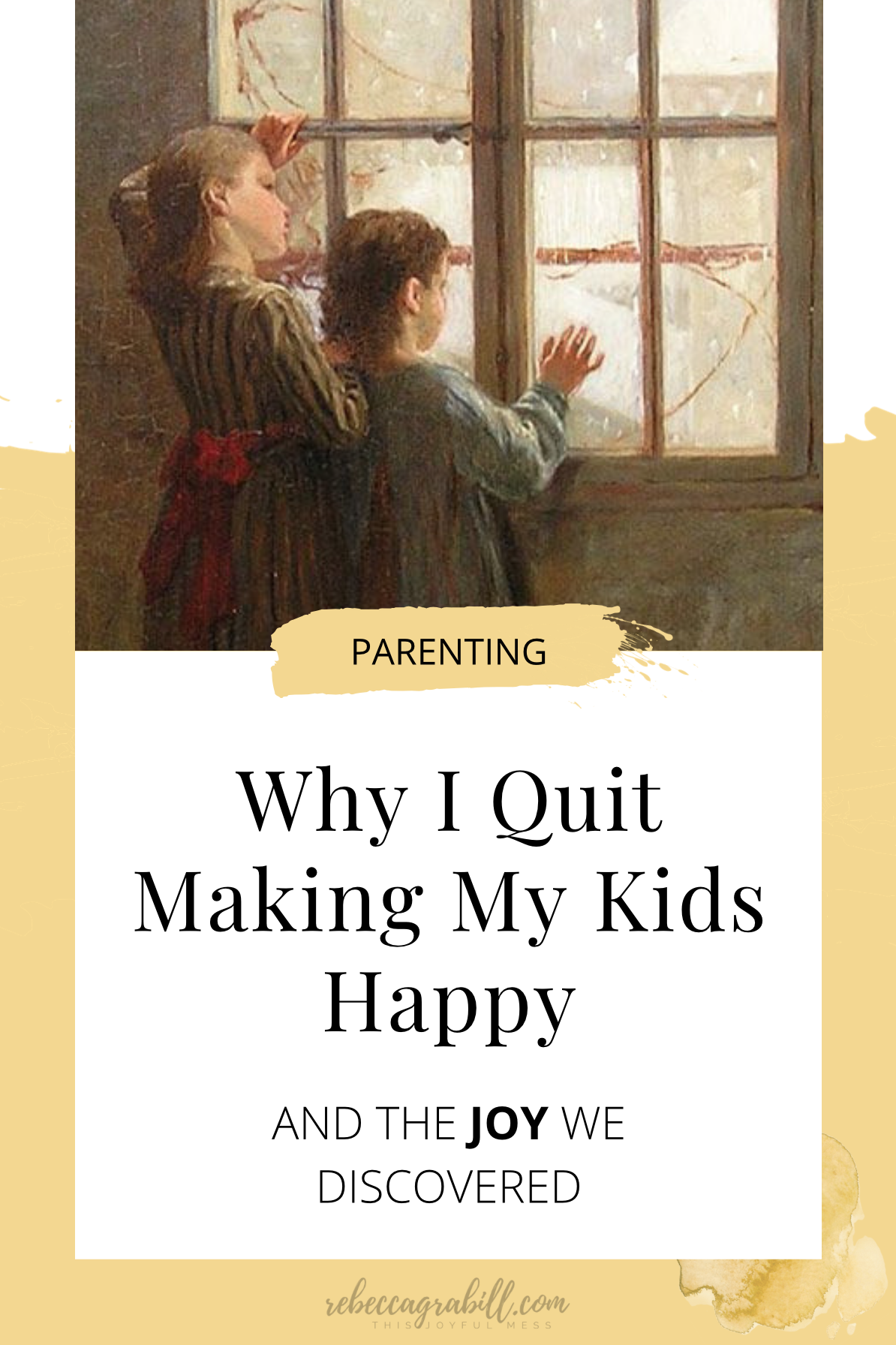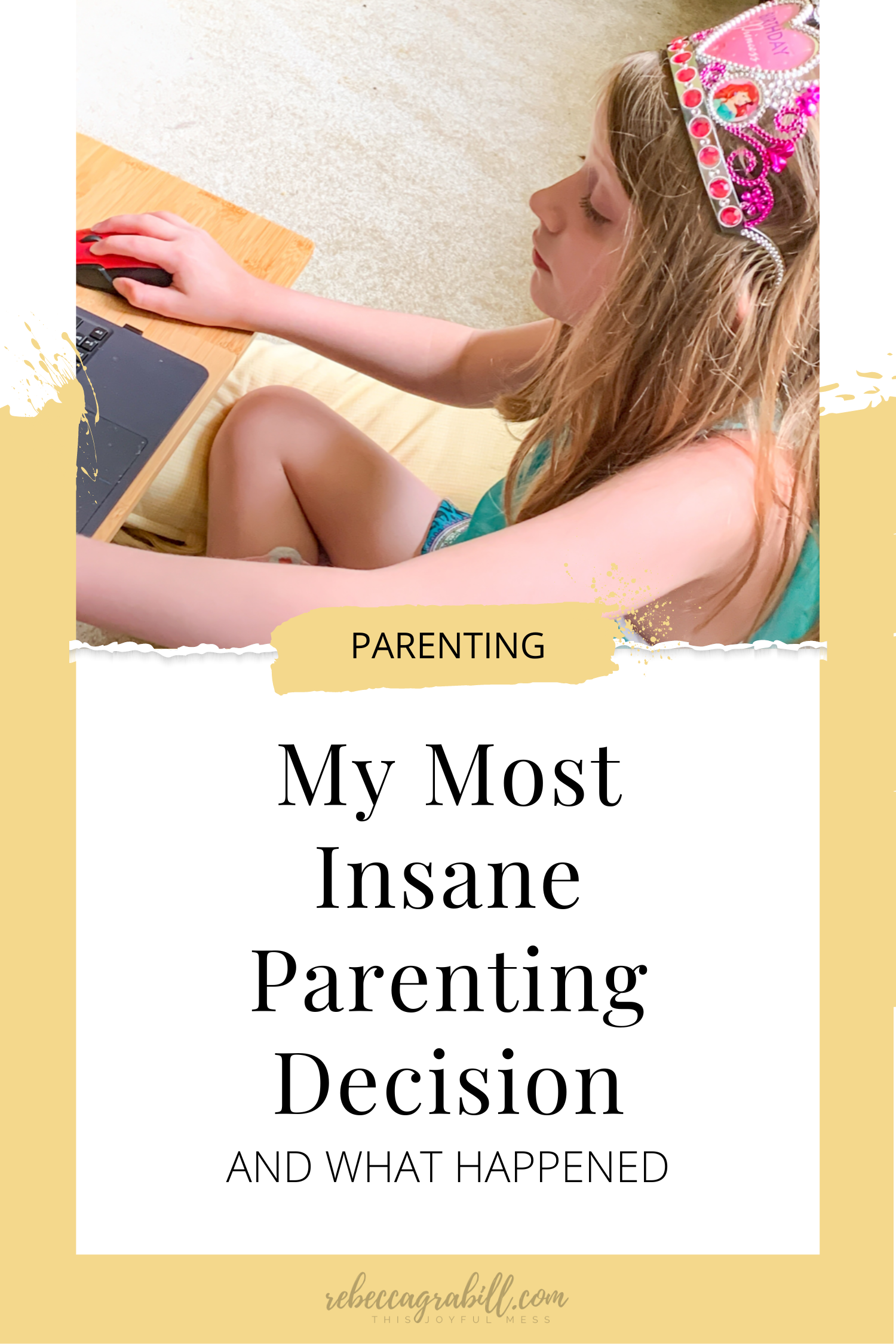My Secret to a Joyful Home? I Quit Making My Kids Happy
I started this motherhood journey in my mid 20s with no idea how hard it would be to make and keep my baby happy. At 9.5lbs he was voraciously hungry. Always. And when his hunger abated, he screamed from colic.
Sleepy? Who, me?!
That look of sweetness was a ploy, a PLOY!
As a toddler, he wouldn’t eat the broken graham cracker, wouldn’t wear the itchy shirt, only liked the original Blues Clues host – Joe would never do.
As a preschooler … a third grader … a middle schooler … the one thing that made him happy and gave me a few minutes of PEACE was a device. A half hour on an archaic desktop morphed into a Nintendo DS and then to a first gen iPad … and on it went.
The more he used screens, the more he craved them. The more he craved, the more UNhappy he was when he wasn’t on a screen.
If he was unhappy, we were all unhappy, so the cycle continued. Our world was newly digital when Nicholas was young, and no one was talking about the harms of screen media on children’s development. While the experts weren’t talking about it yet, the parents were living it every day.
I fought the battle through his teens, continued fighting with his younger siblings.
Then I made the most insane parenting decision I never thought I’d actually make.
I’m not going to sugarcoat this. Cutting the digital cord is hard. It hurts. It’s scary for us and for our kids. But it is so, so worth it.
If you’re like I was, your kids use more digital media than you’d like. Maybe they’re into video games, binging episodes of Bluey, mindless scrolling through YouTube. If you’ve ever had the thought, “I sure wish he’d do something that doesn’t involve a screen,” then you a. Have a problem b. Are in the perfect position to solve it!
Here’s a truth that our culture has forgotten: we are the parents. This means that while it’s our privilege to love on our children, it’s also our responsibility to keep them healthy and safe. A parent is not …
… a buddy there to have fun
… a counselor to actively listen
… a lifeguard to make sure they don’t stray into the deep end.
A parent is all of that combined, and more.
“Love is patient, love is kind. ”
We all know that parenting involves love. Love is like a coin. On one side has all the gentle kindnesses we show our kids. Cuddles, kissed boo-boos, storytimes and lullabies, long conversations (thinking teens here), hugs, wiped tears, encouraging words.
But there’s a second side to the coin of LOVE, one our modern culture has downplayed or eradicated altogether.
That second side to parental LOVE is authority. We are our kids’ parent. Their boss, the good cop and the bad cop, we are the ones in charge.
This may rub some the wrong way. Some of us grew up with parents who used their privilege of authority to bully, coerce, or do harm.
But even if we have authority issues ourselves, and I’ll raise my hand, we have still been given a role of authority for our kids. And, you know what? Our kids NEED our authority every bit as much as they need our affection.
I struggled with this as a new mom. I didn’t like telling my child No, I wanted to be his friend, for all our days to be full of fun and delight. But the more I said yes, the less joy we had.
Studies have shown that a house without rules, where kids free range to do what they want when they want it, yields kids with anxiety, low self image, and a whole range of emotional and behavioral troubles.
I Just Want My Kids to Be Happy!
There’s a notion going around that the goal of life is personal happiness.
Not only is this quite self-absorbed (and hedonistic!), it’s also IMPOSSIBLE.
Happiness is a temporary state of being.
Happiness is transient.
It’s supposed to be. If a rose blossom never wilted, would it be as beautiful?
Just like sadness, like grief, like elation, like anxiety, like calm.
Nobody wants to stay in sadness or grief forever, obviously, and if we’re honest, we don’t want to stay in peaceful calm or giddy delight forever either. Otherwise we’d never watch a thriller, read a tragedy, or listen to a classic country love song.
An emotion is temporary. Happiness is transient. It’s supposed to be.
The harder we chase that happy high, the farther away the next happy high is going to be.
The real goal is contentment, and contentment isn’t a feeling. It’s a decision. But that’s another conversation.
We can and should want our kids to be happy, but our kids’ happiness can’t be the goal of parenting. We can’t be good parents and make our kids happy all the time.
They need us to occasionally make them unhappy. I’d say I make my kids unhappy on a regular basis, and I’m glad for it. It means I’m doing my job!
Last summer a nasty bug swept through the house and it turned into a sinus infection for every single one of us. Every. Single. One of the seven living at home ended up on antibiotics.
The challenge: sometimes kids don’t like taking their medicine. Emeric is one of those kids.
It takes two of us to get that first dose in. One to hold flailing limbs, one to shoot the medication syringe into his screaming mouth. Wow, he is unhappy for sure! I can minimize his grief with distraction, games and other parent tricks, but there’s no way for me to make him happy AND make him take the hated medicine. Getting meds into his feverish little body is my job.
One evening during our month-long illness, Emeric (yes, the same who didn’t like his antibiotic) walked up to me with the children’s Tylenol bottle in his hand. He asked me to open it. He loves the flavor of children’s painkillers!
Opening that bottle so he can drink the whole thing would make him SOOOO happy! So as a good parent, did I let him drink the whole bottle of Tylenol?
Of course not!! When I took the bottle away and put it out of reach (and out of sight because I’m not a monster!), he was again very, very unhappy.
As a parent, it’s my JOB to make sure my children are safe and protected. It’s my job to make sure they get adequate sleep, enough healthy food, don’t drink whole bottles of liquid Tylenol, and DO take their medication on schedule.
This is just as true for what they put into their little bodies as what they put into their minds.
You can read the outcome of our change in screen media in an earlier post, how it truly revolutionized our home. But one final word, one that was a surprising revelation to me …
We are responsible for what our kids do online.
Both morally and legally.
I shared my reasons for eliminating screen media for my younger children are young, my biggest concerns being about their brain and heart development.
And I wrote about my teens, also primarily focussed on their hearts and souls.
And yes we absolutely have a responsibility to ensure the “food” going into our children’s hearts and minds is high quality, nutritious, healthy. But wait, there’s more…
Did you know that if my child – even my teen – harasses someone online, I, as his parent, could be held legally responsible? Parental liability is a legal term for the responsibility a parent or guardian has for the negligent or criminal acts of their child.
“Parental liability is a legal term for the responsibility a parent or guardian has for the negligent or criminal acts of their child.”
If my fourteen-year-old sneaks out at night to steal a car and gets in a wreck, I won’t face the same charges as I would if I’d done it myself, but I might be charged with vicarious liability. Likewise, if he steals credit card numbers, bullies someone or exploits someone, even from the safety and secrecy of his bedroom, I share responsibility for his crime.
It’s my internet network, more than likely my device (or one I purchased and gave as a gift), and it’s my JOB to make sure he uses both appropriately.
In coming weeks I’ll share my full:
Seven-Step Guide to Digital Freedom for Your Kids
Here’s a preview for what’s coming:
1 Take Inventory
Identify how much screen time our kids really consume, including streaming, gaming, social media and smartphone use and learn about the current recommendations for screen media, what type of media is better or worse, and what screen use does to developing brains. I have a handy-dandy printable Daily Media Log linked in this post.
2 Prepare the Environment
Tips for engaging kids interactively in every room of the house as well as outside the house! A full guide with links and resources for making our spaces engaging, entertaining, inviting, educational, restful.
3 Plan ahead
A guide for planning alternate activities (not necessarily parent-led!) for your heaviest screen times to make the transition easier and sustainable.
4 Have an age-appropriate conversation
Who needs guidance for talking about screen use with a toddler, or how about a teen? I’ll share scripts and Q&A for each age group as well as tips for dealing with objections, because we know there’ll be objections! I’ll also share tips for scaling back total elimination isn’t possible or desirable for your family.
5 Set up a digital safeguard & scale back
Here I’ll talk about the initial steps of actually drastically decreasing or eliminating screen dependency in our children. The first is scaling back and the second is safeguarding our network and devices so when screens are used, kids will be protected from the many (many) online dangers.
6 Cut the cord
The almost-final step. It’s go-time, the Big Day. How, what, when, where, and a bit more reflection on why (what we and our kids will GAIN by losing!). This is our huddle, our pep talk!
7 Stay strong
Real world problem-solving and trouble-shooting with tons of recommendations for dealing with drama, growing our parenting library, and freeing ourselves from screen over-use. Because doesn’t Mama need to lead by example?
Subscribe to be notified when the 7 Step Guide is available, or check back soon! And until then, share your stories below. How have screens impacted you or your kids? Do you set limits, and how well do they work?







